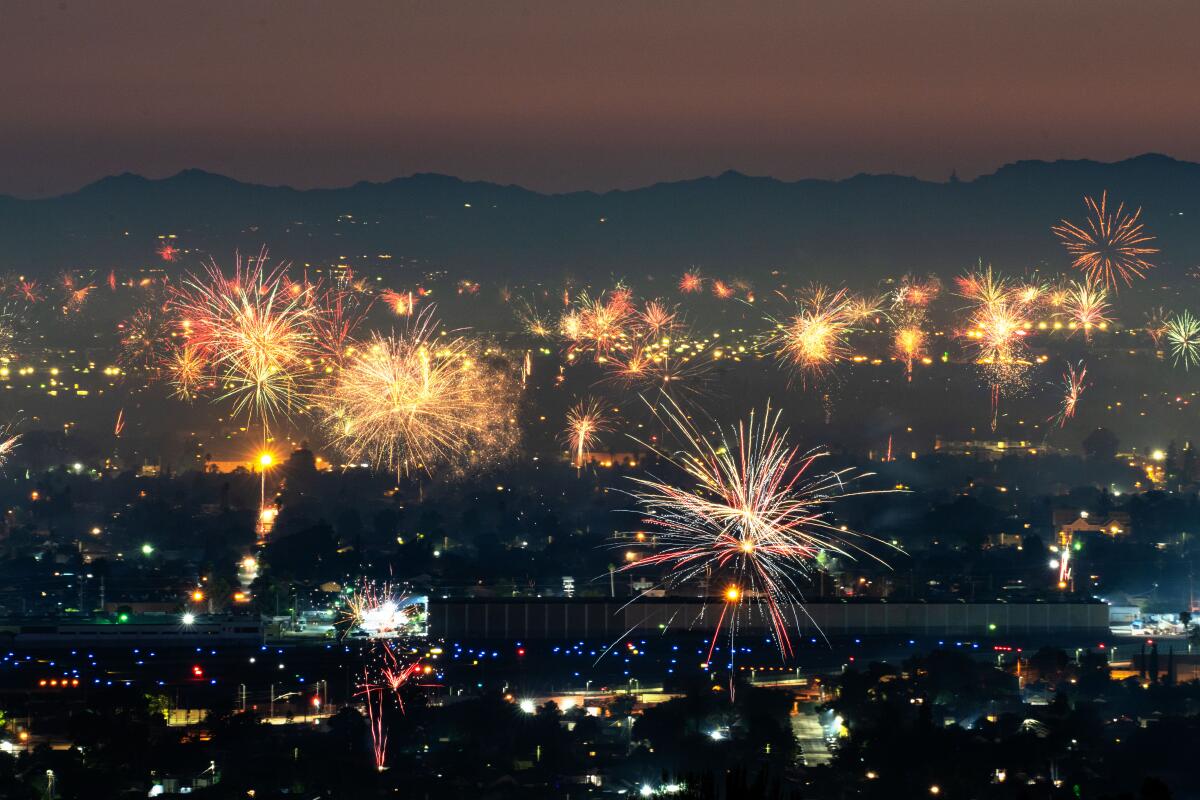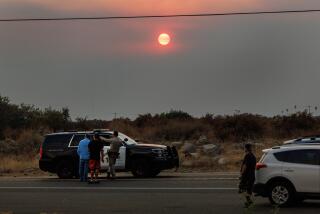L.A.âs extreme fireworks bring terrible air quality, increased calls for fire service

With officials canceling Fourth of July fireworks displays because of the coronavirus outbreak, many in Los Angeles County decided to put on their own show â leading to surges in both air pollution and calls for emergency services.
L.A. firefighters responded to thousands of emergency calls Saturday and extinguished at least one large blaze that consumed half an apartment complex in Northridge, officials said.
The fireworks also caused levels of fine-particle pollution to skyrocket, leading air quality to be rated as hazardous in some areas well into the following morning.
âIt definitely was one of our worst years for July 4 and July 5 fireworks episodes,â said Philip Fine, deputy executive officer for planning and rules for the South Coast Air Quality Management District.
The Los Angeles Fire Department, which serves the city of Los Angeles, averages just under 1,400 calls for service over a typical 24-hour period. On Saturday, it responded to 1,738 calls for service, spokeswoman Margaret Stewart said.
âAs it always is, the Fourth of July was a busier night for all different types of fires,â she said.
They included 200 calls reporting rubbish fires, 103 reporting tree fires, 40 reports of structure fires, 28 of grass fires and 11 of brush fires, she said.
The Los Angeles County Fire Department, which serves unincorporated L.A. County and 59 cities, also saw a higher-than-normal call volume. The department responded to 1,676 calls for service Saturday, compared with an average of 1,100 to 1,200 calls, said Sky Cornell, public information officer. Nearly 500 of those calls were received between 9 and 10 p.m., he said.
That was an increase even from last yearâs Fourth of July, when county firefighters responded to 1,349 calls. In fact, it was the second-busiest day in the departmentâs history, second only to Feb. 17, 2017, when firefighters responded to 1,777 calls during a rainstorm, Cornell said.
The calls for service to which firefighters were dispatched included 370 outdoor fires, 44 structure fires and 13 brush fires, he said. County fire officials were working Sunday to determine how many of the calls were related to fireworks.
In the city of L.A., the most serious incident took place when fireworks ignited several large palm trees in Northridge and the flames spread to a neighboring apartment complex, destroying several units and displacing about 50 residents, Stewart said.
âWhereas people like to disregard and create their reasons for why they think fireworks are illegal, last night proved the point in terms of a tree fire that extended into an apartment building,â Stewart said.
The fire was reported in the 8600 block of North Wilbur Avenue shortly before 9:30 p.m. It took 81 firefighters 43 minutes to extinguish the palm trees and eight apartment units that were fully engulfed, officials said. Multiple residents were rescued, and three people were hospitalized for smoke inhalation, the Fire Department said.
Embers from the burning palm trees also spread to the roof of a second eight-unit apartment building in the complex, starting a surface fire, but firefighters were able to put it out before it caused major damage, the department said.
An investigation by the departmentâs arson and counterterrorism unit determined the fire was started by illegal fireworks, officials said.
Earlier in the week, L.A. County public health officials announced that the county was temporarily banning fireworks displays and closing beaches to avoid crowding during the holiday weekend in a bid to slow an alarming surge in coronavirus cases.
The city of Lancaster chose to defy the ban by holding a public fireworks show at the Lancaster National Soccer Center. Parking lots were closed, and residents were encouraged to watch from their homes or isolated outdoor areas.
The cityâs mayor framed the move as a political statement in comments on social media.
âThe ultra left is trying to steal 4th of July,â Mayor R. Rex Parris wrote on Facebook. âIn our city, we celebrate being Americans. Please come visit me in jail, because no one is going to stop 4th of July in our city.â
The display, which was livestreamed on the cityâs Facebook page, took place without incident.
Despite the relative dearth of official fireworks shows, the backyard displays left the region dealing with poor air quality. Fireworks emit high levels of particulate matter known as PM2.5, and July 4 and 5 are typically among the regionâs worst days when it comes to high levels of the pollutants in the air, health officials said.
But this year, the PM2.5 pollution appeared to be more concentrated and linger for longer even compared with past holidays, officials said.
While the air quality usually reaches very unhealthy levels on July 4 and 5, this year some areas reached hazardous levels. Hazardous air quality was first reported about 10 p.m. in central Los Angeles County, an area centered on downtown L.A., and didnât significantly improve until about 8 a.m. Hazardous conditions also were reported in Anaheim from about midnight to 1 a.m.
Stagnant weather conditions were probably a big contributor, the Air Quality Management Districtâs Fine said.
âWhen the atmosphere mixes a lot, you get cleaner air from up above mixing with dirty air from activity down below, and the smoke dilutes and doesnât build up,â Fine said. âBut an inversion layer means you donât get that mixing so it gets trapped.â
On Sunday morning, the inversion layer was almost at ground level, compared with the height of 1,000 to 1,500 feet that is typical for this time of year, he said.
âWe also donât know for sure but anecdotally weâve had reports of a lot of backyard and neighborhood fireworks shows, maybe to replace some of the larger shows that were canceled,â Fine said.
He noted that many professional fireworks shows use smokeless launchers that propel fireworks into the sky with compressed air, whereas people at home tend to use rocket-launched fireworks. Itâs also possible that the chemical compositions of some backyard fireworks are more polluting than those used by professionals, or there were simply more of them, he said.
The PM2.5 pollution was dissipating as the day went on and was expected to continue to do so, Fine said. Still, children, older people and those with respiratory conditions were being advised to avoid prolonged outdoor activity in some areas, which included portions of the coast and parts of the San Fernando and San Gabriel valleys.
The increase in pollution, albeit temporary, raised an additional layer of concern in light of the recent increase in coronavirus cases that have prompted public health officials to tell people to redouble efforts to stay at home and avoid unnecessary contact with others.
âThereâs obviously a lot of research that has been done over the last several months on COVID,â Fine said. âThe studies Iâve seen have shown that yes, people with preexisting respiratory conditions are more susceptible, more likely to contract or have worse symptoms from COVID.
âWe also know that poor air quality and long-term exposure to poor air quality can cause some of those preexisting respiratory conditions. We also know that on a day-to-day basis, those conditions can be made worse by poor air quality, which can make you more susceptible to contracting the virus. So there is a connection there.â
Meanwhile, drier conditions, hotter temperatures and high winds in some parts of L.A. County raised concern about the potential for fires to spread quickly.
Minimum humidity dropped to the single digits and teens in many inland and foothill areas on Sunday, while high temperatures in those areas were forecast to reach up to 10 degrees above normal, the National Weather Service said.
Gusty winds were expected to hit the Castaic Lake area, mountains of Ventura County and the south coast of Santa Barbara County on Sunday night. The âsundownerâ winds are northerly winds driven by differences in pressure that tend to strengthen in the evening and overnight hours, said Lisa Phillips, meteorologist for the National Weather Service in Oxnard.
Combined, the weather conditions create an elevated fire risk that is not unusual for this time of year, she said.
âIn this time period, weâre dealing with a lot of conditions starting to reach elevated fire weather conditions, just periodically,â Phillips said. âWeâre in our fire season now.â
Temperatures were expected to cool off gradually starting Monday, with coastal areas seeing highs in the mid-70s and valleys in the upper 80s by Thursday, ahead of another warm-up forecast for Friday. But the increased risk of fire was expected to persist, Phillips said.
âReally, everyone should be considering most days to be elevated, just in terms of precautions we have to be taking with the season changing,â she said.
More to Read
Sign up for Essential California
The most important California stories and recommendations in your inbox every morning.
You may occasionally receive promotional content from the Los Angeles Times.











